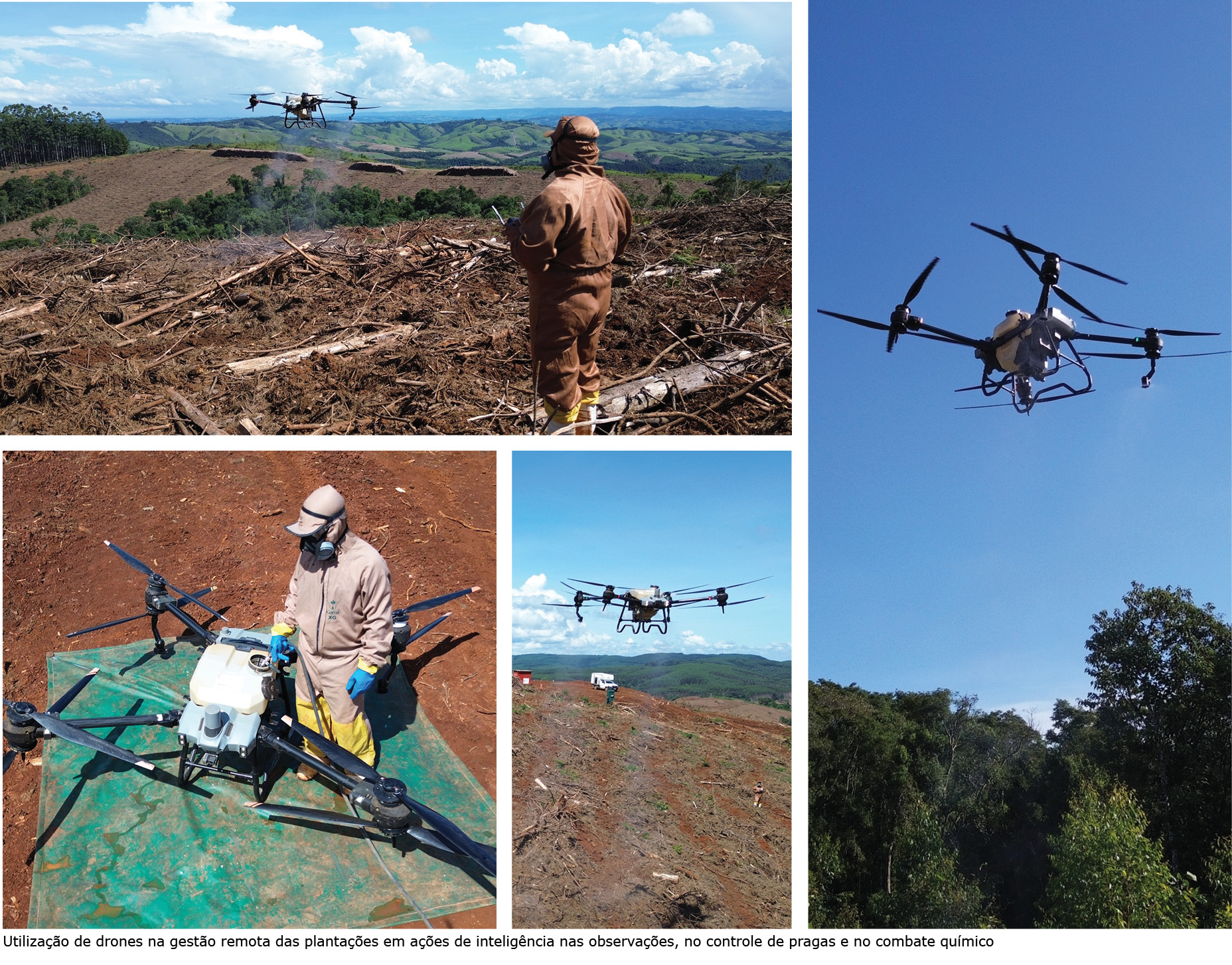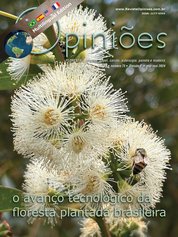Daniel Carvalho de Moura
Diretor Florestal do Grupo Plantar
OpCP75
A utilização de drones em tratos culturais da floresta
Em fevereiro de 2024, a Plantar completou 57 anos de atuação no setor florestal. Desde 1967, temos participado da história da prestação de serviços florestais em várias regiões do Brasil. Atuamos em diversas empresas, participamos de inúmeras feiras e já viajamos para dentro e fora do país. Por esses motivos, temos a grata satisfação de ter acompanhado toda a evolução tecnológica do setor nas últimas décadas.
Em especial, a utilização de drones tem sido, nos últimos anos, a resposta mais assertiva para a uma série de demandas antigas do setor. Neste texto, gostaríamos de destacar as vantagens da aplicação de caldas via drone, bem como a adubação sólida, em aspectos como segurança, economia, manejo e inovação.
Segurança:
A aplicação de caldas via drone é precisamente programada, pois é necessária a identificação de todos os obstáculos que, muitas vezes, não estão atualizados nos mapas das empresas. De olho na segurança da atividade, previamente à aplicação é enviado um drone de asa fixa que faz fotos de todas as áreas florestais. Em seguida, é realizado o processamento das imagens para definição dos polígonos de aplicação, bem como a identificação e o georreferenciamento dos obstáculos. Deste modo, quando o drone de aplicação finalmente é enviado para missão, toda área está precisamente mapeada (georreferenciada), o que garante que a operação ocorra de forma segura, produtiva e com muita qualidade.
É importante destacar, também, que as aplicações de caldas via drone são devidamente regulamentadas por órgãos oficiais, como a Agência Nacional de Aviação Civil (Anac), Agência Nacional de Telecomunicações (Anatel), Departamento de Controle do Espaço Aéreo (Decea), Ministério da Agricultura e Pecuária (Mapa), além de cumprirem com exigências estaduais específicas. Os pilotos de drones são credenciados por meio de cursos destinados à formação e à capacitação para a operação dos equipamentos.
É possível que haja mais de um drone em operação em um mesmo talhão, mas com pilotos independentes, devido a exigência legal, tudo para a segurança do processo. Os veículos de apoio à operação são devidamente adaptados para transportar insumos de forma segura, bem como geradores, baterias, controladores, misturadores e demais componentes básicos.
As áreas de vivência são adequadas para apoio às refeições, e os sanitários para o número de duas a quatro pessoas, a depender da quantidade de drones em atuação no mesmo talhão. Para além dos talhões, é muito importante o cuidado com as áreas adjacentes, de modo a manter uma faixa segura de proteção às áreas de vizinhos.
As hélices dos drones produzem um efeito que contribui bastante para minimização de derivas (downwash), mas, ainda assim, é muito importante respeitar as condições meteorológicas indicadas para a aplicação, sobretudo os ventos. É importante que a equipe de aplicação tenha condições de aferir as condições meteorológicas no local e no momento da aplicação.
Economia:
Os drones e os seus softwares de gerenciamento têm evoluído a cada nova edição, tanto em autonomia das baterias, quanto em capacidade de carga. A cada dois anos são comprovados um ganho na ordem dez litros de capacidade de voo. Isso significa que o mercado está próximo da transição da geração de drones de 40 litros, para drones de 50 litros de capacidade.
A tecnologia de aplicação via drone possibilita, ainda, uma redução do consumo de água de cerca de 200 litros de calda para algo em torno de 37 litros de calda por hectare. Já o consumo de combustível é reduzido para apenas 10% do volume de consumo de uma atividade convencional.
Além disso, a aplicação de caldas via drone não gera compactação de solo, não necessita de grande estrutura de apoio para a operação e não exige grandes investimentos em estradas ou em equipamentos de porte elevado. Os tratos culturais são realizados com uma pegada de carbono muito menor.
Manejo:
Outra vantagem do uso de drones é que eles dão acesso preciso aos ponteiros das árvores. Nestes locais estão as gemas de crescimento, onde é possível depositar insumos capazes de contribuir para a saúde e o desenvolvimento das plantas.
Insumos biológicos, responsáveis por combater pragas, doenças e contribuir para a saúde do solo e da planta, podem ser utilizados em consórcio com insumos minerais, ou mesmo com herbicidas, no auxílio da biorremediação do solo. Além disso, extratos vegetais contribuem para o aumento da eficiência dos herbicidas de modo a reduzir a quantidade aplicada. De maneira geral, com essas técnicas, há aumento da eficiência das aplicações na absorção foliar ou na raiz, além de um ganho ambiental incrível.
Em casos de aplicação destinada à dessecação de áreas com grande volume de massa vegetal, não há mais o problema do “efeito guarda-chuva” gerado pelos pneus das máquinas. Também, é possível fazer os tratos culturais em áreas com tocos altos e grandes volumes de resíduos florestais, ou mesmo com impedimento na borda dos talhões. É possível realizar tratos culturais até mesmo onde há estreitamento de linhas de plantio, uma vez que o trânsito dentro do talhão não é mais obstáculo para a realização das atividades. Além de todas essas vantagens, é possível operar com grande eficiência em áreas de topografia inclinada, onde não é possível o tráfego de máquinas e a atividade manual se torna muito desgastante.
Inovação:
Além de uma operação segura, produtiva economicamente e de alta qualidade, com menos gastos de recursos naturais, há novas perspectivas com a combinação de drones com outras tecnologias.
As atividades realizadas nos talhões são todas registradas em um portal na rede, seja software próprio ou nativo do fabricante. Por sua vez, os controladores de voo fazem a conexão com os drones e armazenam os dados de cada voo. Uma vez com acesso à internet, os controladores executam a transmissão dos dados.
Com a combinação de redes satelitais ou via rádio, é possível fazer o acompanhamento em tempo real das atividades. O gerenciamento online das atividades florestais, com todas as informações reunidas em uma “torre de controle”, tem sido uma prática muito assertiva na gestão de recursos operacionais das empresas florestais. Porém, não se esqueça de pensar em sistemas alternativos de transmissão de dados, já que em alguns locais onde as operações são realizadas pode não haver acesso à internet.
Quando pensamos em atividades florestais georreferenciadas, sobrepostas em camadas nos modernos sistemas de informações geográficas, temos um universo de novas oportunidades, tais como planejar melhor as nossas operações; executá-las com alto grau de segurança, qualidade e produtividade; operar em áreas anteriormente inviabilizadas pela dificuldade de execução dos tratos culturais, entre outras.
A adoção de tecnologias complementares de transmissão de dados, a geração de imagens NDVI, os sistemas que ajudam a planejar com um número enorme de variáveis, os algoritmos que auxiliam na tomada de decisão e no planejamento do manejo correto para cada talhão são ferramentas do presente que podem nos levar a um futuro de florestas cada vez mais sustentáveis e produtivas.
Mas, atenção: é fato que adquirir e assimilar tecnologias novas é sempre muito estimulante. Contudo, o diferencial permanece com as pessoas. No desenvolvimento de florestas sustentáveis, bons gestores que trabalham as motivações e os propósitos de suas equipes em prol de uma sociedade melhor são inspiradores e merecem todo crédito.
Quando amamos o que fazemos, não nos apaixonamos pelas tecnologias e nos perdemos nelas, mas as utilizamos com a habilidade necessária em favor da segurança, produtividade e qualidade das nossas florestas. Não podemos fazer da tecnologia um fim, mas um meio para a sustentabilidade e a prosperidade dos negócios florestais.
Antes de encerrar, gostaríamos de encorajar você, nosso leitor, a trilhar esses novos caminhos rumo à adequação do seu negócio florestal. Vá em busca de todas as possibilidades que a conectividade lhe permite. Desenvolva a utilização de insumos mais sustentáveis. Desejamos a você boas florestas e bons negócios!





